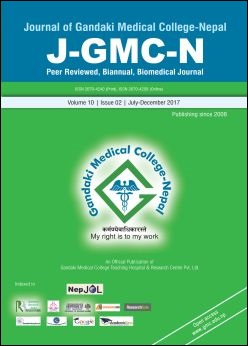Study on the Relativity between Cytogenetics and Cytomorphology and its Prognosis Significance in Children with Acute Myelogenous Leukemia
DOI:
https://doi.org/10.3126/jgmcn.v10i2.20806Keywords:
Abnormal karyotypes, Acute myeloid leukemia, Cytogenetics, PrognosisAbstract
Objective: The main objective of this study was to retrospectively evaluate that the cytogenetic abnormalities is an important prognostic factor for the cure of acute myeloid leukemia (AML).
Methods: This retrospective study enrolled newly diagnosed 70 cases (37 males and 33 females, aged 10.1 months to 14.5 years) of pediatric patients with AML during 2010 January - 2016 February from the Second Affiliated Hospital of Anhui Medical University. Excluding criteria were cases secondary to treatment-related MDS and AML. Samples were obtained from bone marrow cells in patients after treatment on the anterior superior iliac spine, blood diseases laboratory by direct culture or 24/48 hour short-term culture, G -banding technique for testing. Follow-up of 1 - 60 months, the analysis of treatment response rates of different karyotypes, distribution ratios in various subtypes, normal karyotype and abnormal karyotype. ISPSS17.0 software statistics was used for statistical analysis. Groups were compared using chi-square test; Survival rate was calculated by method of Kaplan Meier and survival difference between groups were compared with breslow test.
Results: Among 70 cases, 42 cases were detected for chromosomal abnormalities (i.e. 60% of the total number of cases), M3 abnormal karyotype distortion rate of 78.5%, M2 abnormal karyotype aberrations 63.3%, M4 60.0%, M1 50%, M5 lowest 38.9 %, M7 nuclear aberrations highest rate was 100%. Total chromosomal aberration rate was 60%. Acute myeloid leukemia cases, t (8; 21) at most, there are 15 cases, and the presence of abnormal karyotype 86.7% in the original part of differentiated myeloid leukemia (M2); t (15; 17) has 11 cases, exists only in acute promyelocytic cell leukemia (M3). After treatment, the remission rate of t (8; 21) was 80%; the remission rate of t (15; 17) was 90%; the remission rate of other abnormal karyotype abnormalities was 50%; the remission rate of total abnormal karyotype was 71.4%. The event free survival rate was significantly different between normal karyotype, t (8; 21), t (15; 17) and other abnormal karyotype groups (P<0.05).
Conclusions: Acute myeloid leukemia karyotype abnormalities among FAB subtypes are different; M3 is the highest rate of abnormal karyotype aberrations, M2, M4 medium, M5 minimum. t (15; 17) seen in acute promyelocytic leukemia (APL), prognosis is good; t (8; 21) is more common in M2, prognosis is good, also found in M4 and M5, worse prognosis; +8 Abnormalities found in AML M2, M3, M4, M5 and M6 subtypes, prognosis medium; inv (16) high white blood cells, low platelet poor prognosis, AML patients with normal karyotype prognosis medium.
J-GMC-N | Volume 11 | Issue 01 | January-June 2018, Page: 35-41
Downloads
Downloads
Published
How to Cite
Issue
Section
License
This license allows reusers to distribute, remix, adapt, and build upon the material in any medium or format for noncommercial purposes only, and only so long as attribution is given to the creator.

